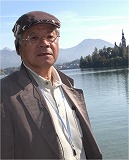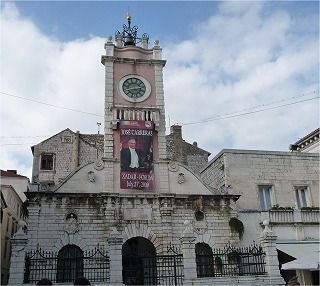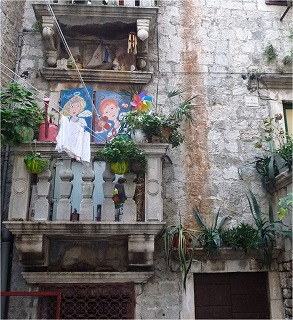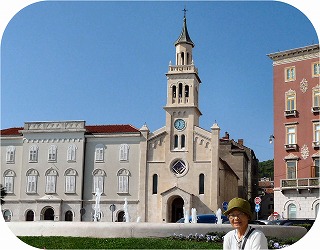|
 |
|
|
|
(S): Slovenia, (C): Croatia,
(M): Montenegro, (B): Bosnia-Herzegovina |
|
|
2-1. Zadar, Croatia
October 5 |
|
|
We drove south from Postojna, Slovenia, yesterday, and stayed in the town
Opatia, Croatia, located at the north-westernmost of Balkan Peninsula facing
the Adriatic Sea.
Now this morning we left Hotel Opatia at 7:30, and drove fast along the
seacoast south to south for 400 km. It took about six hours with lunch
time.
The temperature this morning was below ten degrees, and it went up and
up to 25 degrees when we got to Zadar.
|
|
|
This historic town Zadar facing the Adriatic Sea is little impressive in
my mind after the travel somehow due to the adverse effect of the serene
weather.
At the seashore Emiko said, "This town looks like Monaco." Thinking
so too, I looked around and remembered the travel two years ago in autumn
when we toured around France from Monaco ending to Paris. The weather at
Cote d'Azur was all the same here.
The dike along the sea is called a "sea organ", a grand instrument
playing the sound of waves like a pipe organ. When the sea is running high
or ships are kicking up waves, what sound does the dike play? Now the sea
is so calm that it plays only quiet sounds on and off.
Hearing the feeble sounds far from the symphony No. 3 with Organ composed
by Saint-Saens, our couple sat on stone steps and were relaxed for a while.
Several sail boats were nice accessories in the calm scenery.
|
|
|
|
|
|
|
We walked around the Old Town. It was surrounded by the castle wall and
in it many churches.
 The narrow paths lined by old houses on both sides were stone-paved here
and there said to be put in 15th century, the Renaissance era. The worn-out
surface were slippery, but tasteful with traces of the past. The narrow paths lined by old houses on both sides were stone-paved here
and there said to be put in 15th century, the Renaissance era. The worn-out
surface were slippery, but tasteful with traces of the past.
The walls of many apartment houses retained the vivid traces of bullets
either due to the Allied Forces when this area was under the control of
Italy during the World War 2 or due to the subsequent civil war of Former
Yugoslavia.
Such views here will be seen at most of the visiting places later.

|
|
 We drove from Zadar to the south for 130 km and arrived at Hotel Medina in Trogir a little over 18:00. We drove from Zadar to the south for 130 km and arrived at Hotel Medina in Trogir a little over 18:00.
When got off the bus, I noticed that I had misplaced my jacket and hunting
cap probably at the restaurant for lunch before getting to Zadar.
The cap is a cheap one bought at Super Daiei and about the jacket I planned
to leave it in this trip. So, very little trouble. But what was in the
jacket? Happily the passport, the wallet, ..., the most important things
next to my life are with me. Now I remember what in the pocket of the jacket
was only the tour itinerary sheet.
I have decided not to tell it to the attendant.
- - - - -
On the previous night of returning to Japan, October 10, all members checked
the inside of the bus so as not to leave anything behind. And suddenly.
a young lady cried,
"Whose are these?"
She is holding up my hunting cap and jacket and says she found them on
the front shelf.
I thanked her scratching my head with joy and shame. |
|
|
 |
| - - - - - - - - - - |
2-2. Trogir City, Croatia
October 6 |
|
|
We joined in the optional tour for one hour and a half here in Trogir.
The small island surrounded by the fortress is this town. The bridge connects
the town with the main land. It was authorized as the World Heritage Site
in 1997.
 We had enough time to walk around in St. Rovro Cathedral, the special feature
of Trogir sightseeing. We had enough time to walk around in St. Rovro Cathedral, the special feature
of Trogir sightseeing.
It was built between the end of 12th century and 15th century, with the
Cathedral part in Romanesque style and the upper parts from the second
floor of the belfry in the Venetian Gothic style.
The guide emphasized that this balance was splendid.
|
|
|
Trogir City itself was built as a colonial city of Greece in 385 B.C.,
and the road network of the right angle was constructed around that time.
It is also a historic town with public and private houses, a square and
a fortress built through many generations since the medieval era.
The spaces tucked away on alleys were made use of for clothes-drying areas
with no exception. Not looked like damaging aesthetic appearance, they
were the original scenes to make sense to us with the wisdom for everyday
life alive on the contrary. The similar scenes were often seen in the other
old towns.
|
|
 |
| - - - - - - - - - - |
2-3. Split City, Croatia
October 6 |
|
|
Split, the second largest city next to Zagreb in Croatia, is located along
the Adriatic Sea within 40 km south from Trogir. After leaving Trogir by
bus, we arrived here at 10:30 soon when the attendant began the explanation.
The words often heard during this trip is the "Mediterranean climate".
The peculiar blue sky and fresh air. Clear! It is now late summer here,
not fall in the season. The sea is brilliant emerald-green probably due
to thick salinity. Swimming is probably still OK, as there are several
men and women wearing swimming suits.
After walking along the seashore for 30 minutes, we are going to the desired
Diocletian's Palace.
|
|
|
The palace is located in the center of the Old Town of Split. Diocletianus
(245-313), the Roman Emperor, built it before retirement and stayed here
for several years until his death.
This Diocletian Palace was once a small city accomodating 9,000 people.
The towers stand out each at the facades on the west, north and east sides,
and the south side faces the sea.
It is said that white local limestone and high-quality marble were used
for the construction, and most of the marble were carried from the quarry
on Brac Island nearby. True or not, the marble of the White House of the
US are from the same island.
We looked around this architecture in detail.
The inside and the courtyard remain almost as they used to be, and people
live here now.
It was a strange sight just like in the past 3rd or 4th century when under
the control of the Roman Empire.
|
|
|
I have made sure of the proverb "All roads lead to Rome". I now
feel that the pleasure of the travel in Europe will be different widely
by the degree to know the history of Roman Empire.
When was it that I bought the whole hard-cover set of "The Story of
the Romans" of 12 volumes written by Nanami Shiono? I only read the
first and second books and have stopped it now. I just remember that Diocletianus
appeared a little in the second.
I will begin to restart reading it, truly.
|
|
|
I travelled around Egypt in June last year. Alexandria, the mouth of the
Nile, is famous for Cleopatra. I saw some remains called the pillar of
Pompeii there, which perhaps had some relations with Diocletianus.
I checked the travelogue of mine with this vague memory. Yes, I found the
part.
And yet the power of the Roman Emperor is immeasurable. Even 1700 years
ago, he took over Egypt faraway and expanded its culture.
The following is the part in my travelogue around Egypt in June, 2008.
|
| - - - - - - - - - - - - - |
|
 Like under the nice summer sky in Japan, we enjoyed a wonderful sightseeing. Like under the nice summer sky in Japan, we enjoyed a wonderful sightseeing.
This pillar known as "Pompeii" was built in 293 A.D. by Roman
Emperor Diocletianus. 27m high and 8m in waist circumference, it is made of Aswan red granite.
This is one of the then 400 pillars of the library attached to Serapeum
Temple. How were those pillars carried here to the northern end of Egypt
from Aswan at the southern end, though the Nile River played an impotant
role in transportation?
The temple was destroyed in 391 by Christians, and so, this pillar is the
only one to think of the library.
The underground ruins of the library was vivid enough to impress me. The
unearthed goods lined on the passage were also worthwhile.
|
| - - - - - - - - - - - - - |
|
|
Diocletian's Palace in Roman era is, say, exceptional.
While walking, the guide stopped sometimes and explained the concrete examples
of a transition of architecture from the medieval era to today, pointing
toward the buildings lined on the both sides.
Cipriano de Ciprianis Palace (Romanesque style, 14th century), Old City
Office (Gothic style, 15th century), Milesi Palace (Baroque style, 18th
century), Prokrativ Old Republic Square (Neo Renaissance, 19th century),
Old sulpher hot spring (Art Nouveau, early 20th century).
|
|
 |
|
Making use of free time, we walked on a couple of alleys and enjoyed the
view of the seashore right under the sunshine.
An event of children on a large scale in the square was in full swing.
Dozens of children on the stage, and audiences were hundreds of children
and parents.
Children on the stage are fighting singing matches separated to several
groups. They sing in a loud voice blowing up their cheeks with candies
in their mouths. The audiences are also making a scene.
It was contrary to the quietness in the palace, and also was another different
world unrelated to the misfortune by the civil war of Former Yugoslavia
until a little over ten years ago. |
|
|
|
|
After 2:00 p.m., we left Split and drove south to Dubrovnik for 200 km,
captivated by the beautiful sight with the dotted islands and the coast
across the bay standing out in contrast to the dark-blue sea. Over the
opposite window are passing the trees of olives, armonds, heaths and figs.
The artificial lake Batin, where we had a rest, showed a nice view of nature
with a difference from the historic town. |
|
 |
|
| Part 2 Reading: 17' 59" |
|
|
|
|
|
|
|
(S): Slovenia, (C): Croatia,
(M): Montenegro, (B): Bosnia-Herzegovina |
|
|
| Close |
|
|